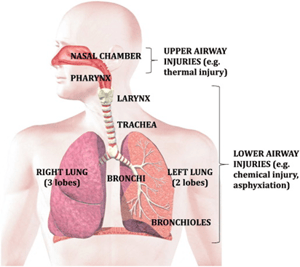 Smoke inhalation is the number one cause of death from fires. In fact, approximately 50-80% of deaths are a result of smoke inhalation injuries rather than burns alone. When smoke is inhaled, harmful particles and gases enter the respiratory system, which can lead to distress syndrome, disorientation, unconsciousness, asphyxia and respiratory failure. Compared to burns alone, smoke inhalation can present more complex clinical challenges, affecting every organ in the body.
Smoke inhalation is the number one cause of death from fires. In fact, approximately 50-80% of deaths are a result of smoke inhalation injuries rather than burns alone. When smoke is inhaled, harmful particles and gases enter the respiratory system, which can lead to distress syndrome, disorientation, unconsciousness, asphyxia and respiratory failure. Compared to burns alone, smoke inhalation can present more complex clinical challenges, affecting every organ in the body.
In this post, we highlight why regular smoke control maintenance is important to keep your buildings legal and safe for occupants.
Why smoke control ventilation systems are vital
As a fire progresses, the volume and toxicity of the smoke produced increases. Before the fire reaches the flashover point, (the point where a relatively ‘small' compartment fire turns into a fully developed fire, engulfing the entire room in flames), the smoke produced becomes extremely thick, black, hot and toxic. Without robust smoke control systems in place, smoke fills buildings quickly, essentially trapping occupants inside the building.
When this smoke is inhaled, it results in three types of physiological injury:
- Systemic effects of toxic gases such as carbon monoxide and hydrogen cyanide, resulting in suffocation and death, if inhalation occurs for around 7 minutes.
- Heat injury to the upper respiratory system whereby the mucous membranes of the airways are burnt, resulting in damage, swelling and potentially airway collapse.
- Chemical injury to the upper and lower respiratory tract resulting from the combustion of furniture/ electrical appliances which produce chemical irritants.
Even non-fatal smoke control injuries can have long-lasting, chronic effects such as:
- 73% of smoke inhalation cases experience respiratory complications and 20% of cases experience acute respiratory distress.
- The risk of pneumonia is increased amongst smoke inhalation patients during hospitalisation.
- Smoke inhalation is associated with long-term illnesses such as emphysema, COPD, chronic bronchitis, pulmonary disease and asthma.• Smoke inhalation is associated with long-term illnesses such as emphysema, COPD, chronic bronchitis, pulmonary disease and asthma.
How a smoke ventilation system can save lives
Smoke vent systems are an aspect of a building's life-safety and fire safety systems and are designed to remove and restrict the movement of smoke while the fire is still burning, thereby assisting occupants with a safe escape.
They are extraction systems that prolong the amount of time that a building's occupants have to safely evacuate, without being overcome by the effects of the smoke inhalation as described above.
Smoke ventilation systems also remove heat from the building. This reduces the number of sprinkler heads that operate to those directly above the fire – prolonging the availability of the water supply. Therefore, it is advised that they work in conjunction with each other, rather than relying on one or the other.
There's no substitute for robust smoke control maintenance and servicing
It is concerning that smoke control maintenance is sometimes combined with fire alarms and security and then sub-contracted out to fire alarm or security operatives. This can be dangerous as not all of these companies are fully accredited or certified to carry out maintenance on complex smoke control systems, which are unique in design and function. Any company carrying out smoke control system maintenance needs to have and IFC certification and be fully compliant with the building regulations laid out in the Regulatory Reform Fire Safety Order 2005.
A smoke test is not a service
Your system is not being robustly tested if your service provider isn't conducting full motor resistance and load tests, checking the battery charge rates and identifying cause and effect of any failures. Smoke control systems require thorough testing on all system types.
Placing the responsibility on building owners
For life safety equipment such as smoke control systems, the building operator or building owner is required by law to provide a suitable system of maintenance to maintain the system in an efficient state, in efficient working order and in good repair.
New guidance on smoke control in multi-occupancy residential buildings has been issued by The Ministry of Housing, Communities & Local Government. The guidance stresses the importance of professional advice and building owners understanding what type of smoke control system they have.
It also reminds building owners that ‘Smoke control systems should be tested weekly by the building owner to ensure that they are operating effectively, with a full system inspection and test carried out by a competent person at least annually.'
The responsible person plays a vital role in ensuring that systems are maintained properly as there are so many things that can go wrong as a result of:
- Smoke equipment being misused by tenants e.g. disconnected fire alarm
- Incorrect advice from unqualified maintenance contractors
- Confusing a smoke test with a service. A successful smoke test will confirm that your system is working now, however, there may be elements within it that are not functioning properly or are reaching the end of their life. Regular servicing by qualified maintenance is vital.
When Colt engineers conduct a site visit, they often find these common mistakes that result in fire safety systems underperforming:
- Items for fire and smoke release not being wired in fire-rated cable
- Magnets used instead of motors on smoke shafts
- Fusible links with screws and bolts fitted joining them together
- Air leaks not fixed properly - we sometimes see insulation tape wrapped around leaking joints to prevent air escaping
- Service provider closing vents down with concrete blocks as a temporary measure.
Such practices are extremely dangerous as these systems cannot be expected to perform at full capacity if a fire broke out, which could result in catastrophic outcomes.
Fully competent servicing by Colt engineers
Colt was the first company in the UK to be certified to both IFC SDI 19 and SDI 05, demonstrating not only our competency in fire strategy, scheme design and installation but also our high standards of service.
Here at Colt, each of our 60 engineers has been expertly trained and accredited. Collectively, the team have unparalleled experience. 14 of our longest serving engineers have an average of 20 years each at Colt.
Our engineers receive continuous training to ensure they always have up-to-date knowledge and skills in the latest technology and regulations.
Planned and regular maintenance can extend the life of an item, reducing the likelihood of downtime. Such a programme also allows the equipment to be updated in line with the latest technological advances and standards.
Find out what to expect from a site visit by a Colt engineer.
If you want to make sure your systems are following the latest maintenance regulations, talk to one of our service specialists today.
 Conor Logan CEng FIMechE FCIBSE is Technical Director of Colt UK. Conor designs innovative smoke control and HVAC systems, represents Colt on many UK and EU standards committees and was Chairman of the Smoke Control Association for over 9 years.
Conor Logan CEng FIMechE FCIBSE is Technical Director of Colt UK. Conor designs innovative smoke control and HVAC systems, represents Colt on many UK and EU standards committees and was Chairman of the Smoke Control Association for over 9 years.


